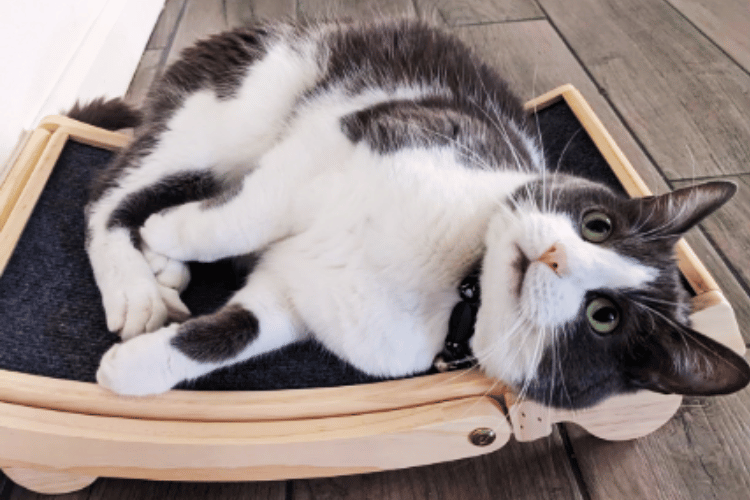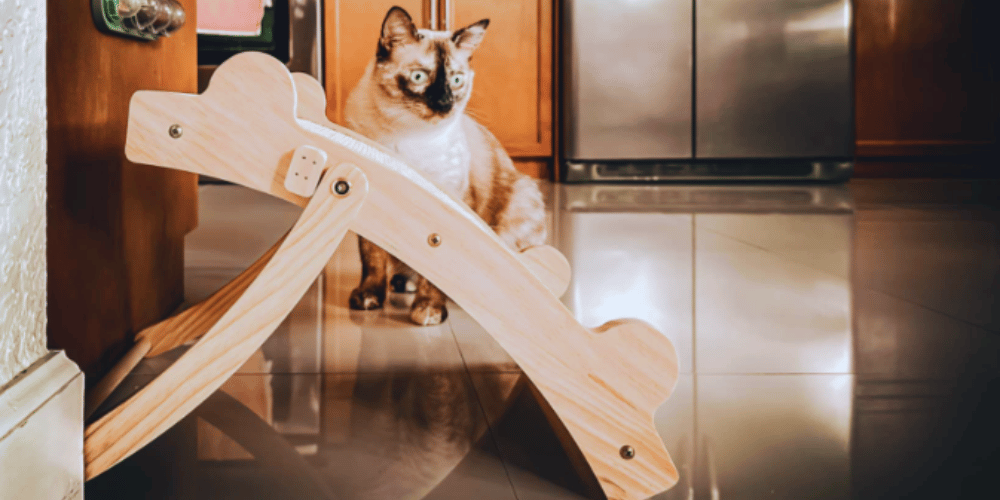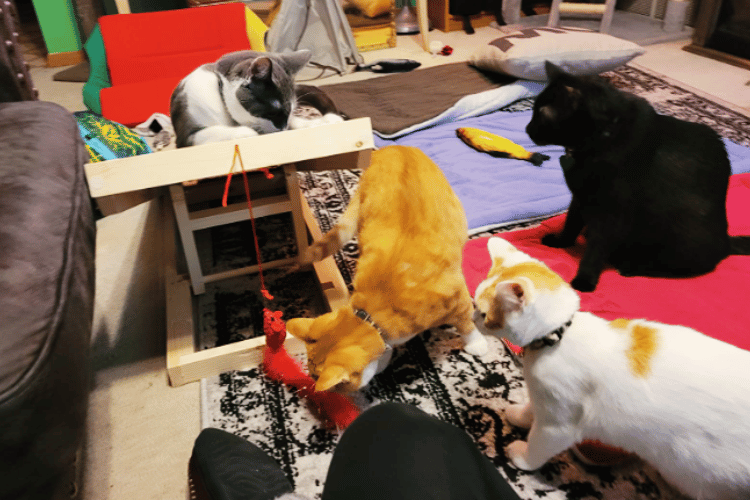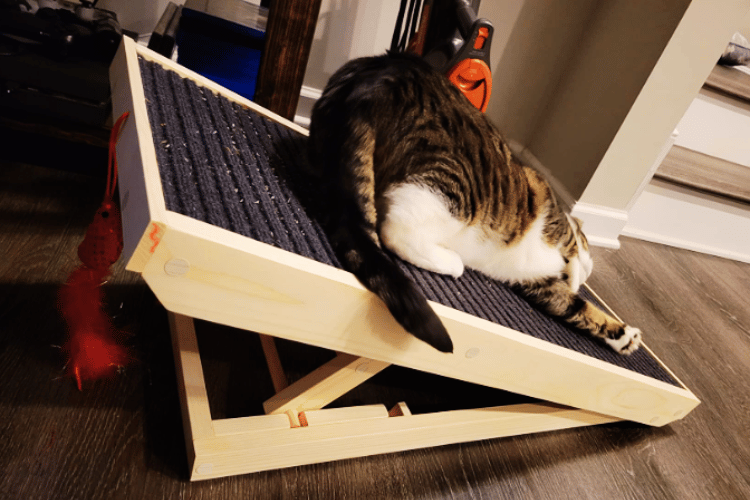Cats are agile creatures, often seen leaping gracefully from one surface to another. However, as they age or face mobility issues, jumping can become a challenge. This is where a cat ramp can be a lifesaver. But, what is the best angle for a cat ramp? This article will guide you through the essentials of creating a safe and comfortable ramp for your feline friend.
Key Takeaways:
- The ideal angle for a cat ramp is between 20 to 25 degrees for optimal ease of use.
- Safety features such as safety rails and carpeting are crucial for preventing slipping and injuries.
- The length and width of the ramp should be tailored to your cat's size and the available floor space in your home.

Understanding the Importance of the Right Angle
When considering the construction of a DIY cat ramp, the angle is a critical factor. A too steep incline can be daunting and difficult for cats, especially for older cats with arthritis or other mobility problems. On the other hand, a ramp that is too flat may take up unnecessary room and may not provide the elevation needed to reach furniture or other raised areas.
The Ideal Slope for Comfort and Safety
The consensus among pet experts is that the best angle for a cat ramp is between 20 to 25 degrees. This range offers a gentle slope that most cats can climb without difficulty. It's steep enough to give them the boost they need but not so steep that it causes strain or increases the risk of falling.
Choosing the Right Materials
When you embark on your DIY cat ramp project, selecting the right materials is just as important as the angle. The ramp should be sturdy enough to support your cat's weight without wobbling. Wood is a popular choice for its durability and ease of customization. Ensure that the surface of the ramp is smooth to prevent splinters and cover it with carpet or another non-slip material to aid in climbing.

Size Matters: Length and Width Considerations
The length of the ramp will directly affect the angle. To maintain the ideal slope, measure the height from the floor to the furniture or platform you want your cat to access. The ramp's length should be sufficient to create a gentle incline. Additionally, the width of the ramp should accommodate your cat comfortably, allowing room for them to move up and down without feeling cramped.
Integrating Ramps into Home Decor
When considering the addition of DIY ramps for your pets, it's essential to think about how they will blend with your home's aesthetic. A ramp should not only be functional but also complement your interior design. For instance, if you have a modern and minimalist house, you might opt for a ramp with clean lines and a neutral color palette. You can even feature the ramp as a stylish element by choosing materials and textures that match your decor. This way, the ramp becomes a seamless part of your home, rather than an afterthought.
Incorporating ramps into your home decor can also mean customizing the featured image credit of the ramp to showcase your personal style. Whether it's by adding a pop of color that matches your living room's theme or by attaching a picture of your older cat or small dog to the ramp, these details can make the ramp feel more integrated into your living space. Additionally, if the ramp is for outdoor use, consider the exterior design of your house. A wooden ramp with a natural finish could complement a garden setting, while a painted ramp could echo the colors of your home's exterior, creating a cohesive look.

Addressing the Needs of Elderly Pets
As pets age, their ability to jump and navigate stairs may diminish, making it difficult for them to move around the house. This is particularly true for an older cat or small dog with arthritis or weakened legs. A ramp with a suitable incline can help these pets maintain their independence and continue to enjoy their favorite spots without trouble. When designing a ramp for an elderly pet, consider a gentler incline rather than a steeper incline to ease their movement. The ramp should also have a non-slip surface to prevent slips and falls.
Moreover, the details of the ramp's design can make a significant difference in the comfort and safety of your aging pets. For example, adding side rails can provide additional security, giving them the confidence to use the ramp without fear of falling off. If the ramp leads to a bed or a couch, ensure that it is flush against the furniture to prevent any gaps that could trip up your pet. Remember, the goal is to develop a solution that will save your elderly companion from the pain and hopelessness of feeling stranded or confined to one level of your house.
Safety Features: Rails and Surface
To enhance the security of your indoor pet ramp, consider adding safety rails along the sides. These rails provide a barrier that can prevent your cat from slipping off the sides. The surface of the ramp should be covered with a material that offers traction, such as carpet or rubber matting. This helps to prevent slipping and makes the ramp more inviting for your pet to use.

DIY Tips: Building Your Own Cat Ramp
For the handy pet owners, a DIY cat ramp can be a rewarding project. Start with two pieces of wood for the ramp section and the platform. Attach the ramp to the platform using screws or a nail gun, ensuring that one end is flush with the floor and the other meets the desired height. Use a staple gun to affix the carpet to the ramp, and consider painting or staining the wood for a finished look.
Placement and Accessibility
The placement of your cat ramp is crucial. It should be positioned in an area that does not obstruct the flow of the room and is easily accessible to your cat. If the ramp leads to a bed or couch, ensure that it aligns properly and provides a stable platform for your cat to land on. The ramp should also be positioned away from busy areas to reduce the risk of tripping hazards for humans.
Encouraging Your Cat to Use the Ramp
Some cats may be hesitant to use a new ramp. To encourage them, place treats along the slope or use toys to lead them up and down. With time and positive reinforcement, your cat will associate the ramp with a helping hand rather than an obstacle.
Maintenance and Upkeep
Regularly inspect your cat ramp for any signs of wear or damage. Tighten any loose screws, replace worn carpeting, and ensure that the ramp remains stable. Keeping the ramp clean and in good repair will extend its life and ensure the safety of your pet.

Summary
Creating the perfect cat ramp involves more than just a few pieces of wood and some nails. The best angle for a cat ramp is between 20 to 25 degrees, which provides a balance between accessibility and comfort. Remember to incorporate safety features like rails and non-slip surfaces, and choose materials that will support your cat's weight securely. With the right ramp in place, your cat can continue to enjoy their favorite perches without the strain of jumping.
FAQ Section
Q: Can a cat ramp be used for dogs as well? A: Yes, a cat ramp can be used for small dogs, especially those with similar mobility problems. Ensure that the ramp is built to support the weight of the dog and that the width is appropriate for their size.
Q: How can I make my cat ramp more attractive in my home? A: You can paint or stain the wood to match your furniture, use carpeting that complements your decor, and ensure that the ramp blends seamlessly with your room's aesthetic. Adding pictures or designs to the ramp's side can also make it a feature rather than just a functional piece.
Q: What if my cat still refuses to use the ramp? A: Patience is key. Continue to encourage your cat with treats and praise. Place their favorite toys or bedding on the furniture the ramp accesses to create a positive association. If your cat is particularly resistant, consult with a veterinarian or a pet behaviorist for additional strategies.
Thank you for visiting LegitLists we hope this helps you make a legitimate choice!






